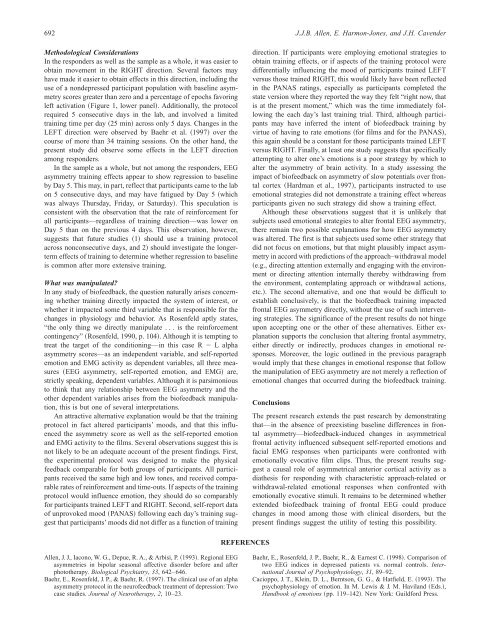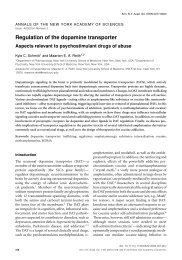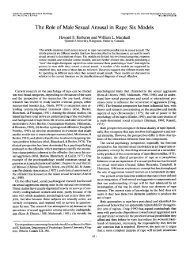Manipulation of frontal EEG asymmetry through biofeedback alters ...
Manipulation of frontal EEG asymmetry through biofeedback alters ...
Manipulation of frontal EEG asymmetry through biofeedback alters ...
Create successful ePaper yourself
Turn your PDF publications into a flip-book with our unique Google optimized e-Paper software.
692 J.J.B. Allen, E. Harmon-Jones, and J.H. Cavender<br />
Methodological Considerations<br />
In the responders as well as the sample as a whole, it was easier to<br />
obtain movement in the RIGHT direction. Several factors may<br />
have made it easier to obtain effects in this direction, including the<br />
use <strong>of</strong> a nondepressed participant population with baseline <strong>asymmetry</strong><br />
scores greater than zero and a percentage <strong>of</strong> epochs favoring<br />
left activation ~Figure 1, lower panel!. Additionally, the protocol<br />
required 5 consecutive days in the lab, and involved a limited<br />
training time per day ~25 min! across only 5 days. Changes in the<br />
LEFT direction were observed by Baehr et al. ~1997! over the<br />
course <strong>of</strong> more than 34 training sessions. On the other hand, the<br />
present study did observe some effects in the LEFT direction<br />
among responders.<br />
In the sample as a whole, but not among the responders, <strong>EEG</strong><br />
<strong>asymmetry</strong> training effects appear to show regression to baseline<br />
by Day 5. This may, in part, reflect that participants came to the lab<br />
on 5 consecutive days, and may have fatigued by Day 5 ~which<br />
was always Thursday, Friday, or Saturday!. This speculation is<br />
consistent with the observation that the rate <strong>of</strong> reinforcement for<br />
all participants—regardless <strong>of</strong> training direction—was lower on<br />
Day 5 than on the previous 4 days. This observation, however,<br />
suggests that future studies ~1! should use a training protocol<br />
across nonconsecutive days, and 2! should investigate the longerterm<br />
effects <strong>of</strong> training to determine whether regression to baseline<br />
is common after more extensive training.<br />
What was manipulated?<br />
In any study <strong>of</strong> bi<strong>of</strong>eedback, the question naturally arises concerning<br />
whether training directly impacted the system <strong>of</strong> interest, or<br />
whether it impacted some third variable that is responsible for the<br />
changes in physiology and behavior. As Rosenfeld aptly states,<br />
“the only thing we directly manipulate . . . is the reinforcement<br />
contingency” ~Rosenfeld, 1990, p. 104!. Although it is tempting to<br />
treat the target <strong>of</strong> the conditioning—in this case R L alpha<br />
<strong>asymmetry</strong> scores—as an independent variable, and self-reported<br />
emotion and EMG activity as dependent variables, all three measures<br />
~<strong>EEG</strong> <strong>asymmetry</strong>, self-reported emotion, and EMG! are,<br />
strictly speaking, dependent variables. Although it is parsimonious<br />
to think that any relationship between <strong>EEG</strong> <strong>asymmetry</strong> and the<br />
other dependent variables arises from the bi<strong>of</strong>eedback manipulation,<br />
this is but one <strong>of</strong> several interpretations.<br />
An attractive alternative explanation would be that the training<br />
protocol in fact altered participants’ moods, and that this influenced<br />
the <strong>asymmetry</strong> score as well as the self-reported emotion<br />
and EMG activity to the films. Several observations suggest this is<br />
not likely to be an adequate account <strong>of</strong> the present findings. First,<br />
the experimental protocol was designed to make the physical<br />
feedback comparable for both groups <strong>of</strong> participants. All participants<br />
received the same high and low tones, and received comparable<br />
rates <strong>of</strong> reinforcement and time-outs. If aspects <strong>of</strong> the training<br />
protocol would influence emotion, they should do so comparably<br />
for participants trained LEFT and RIGHT. Second, self-report data<br />
<strong>of</strong> unprovoked mood ~PANAS! following each day’s training suggest<br />
that participants’ moods did not differ as a function <strong>of</strong> training<br />
Allen, J. J., Iacono, W. G., Depue, R. A., & Arbisi, P. ~1993!. Regional <strong>EEG</strong><br />
asymmetries in bipolar seasonal affective disorder before and after<br />
phototherapy. Biological Psychiatry, 33, 642–646.<br />
Baehr, E., Rosenfeld, J. P., & Baehr, R. ~1997!. The clinical use <strong>of</strong> an alpha<br />
<strong>asymmetry</strong> protocol in the neur<strong>of</strong>eedback treatment <strong>of</strong> depression: Two<br />
case studies. Journal <strong>of</strong> Neurotherapy, 2, 10–23.<br />
REFERENCES<br />
direction. If participants were employing emotional strategies to<br />
obtain training effects, or if aspects <strong>of</strong> the training protocol were<br />
differentially influencing the mood <strong>of</strong> participants trained LEFT<br />
versus those trained RIGHT, this would likely have been reflected<br />
in the PANAS ratings, especially as participants completed the<br />
state version where they reported the way they felt “right now, that<br />
is at the present moment,” which was the time immediately following<br />
the each day’s last training trial. Third, although participants<br />
may have inferred the intent <strong>of</strong> bi<strong>of</strong>eedback training by<br />
virtue <strong>of</strong> having to rate emotions ~for films and for the PANAS!,<br />
this again should be a constant for those participants trained LEFT<br />
versus RIGHT. Finally, at least one study suggests that specifically<br />
attempting to alter one’s emotions is a poor strategy by which to<br />
alter the <strong>asymmetry</strong> <strong>of</strong> brain activity. In a study assessing the<br />
impact <strong>of</strong> bi<strong>of</strong>eedback on <strong>asymmetry</strong> <strong>of</strong> slow potentials over <strong>frontal</strong><br />
cortex ~Hardman et al., 1997!, participants instructed to use<br />
emotional strategies did not demonstrate a training effect whereas<br />
participants given no such strategy did show a training effect.<br />
Although these observations suggest that it is unlikely that<br />
subjects used emotional strategies to alter <strong>frontal</strong> <strong>EEG</strong> <strong>asymmetry</strong>,<br />
there remain two possible explanations for how <strong>EEG</strong> <strong>asymmetry</strong><br />
was altered. The first is that subjects used some other strategy that<br />
did not focus on emotions, but that might plausibly impact <strong>asymmetry</strong><br />
in accord with predictions <strong>of</strong> the approach–withdrawal model<br />
~e.g., directing attention externally and engaging with the environment<br />
or directing attention internally thereby withdrawing from<br />
the environment, contemplating approach or withdrawal actions,<br />
etc.!. The second alternative, and one that would be difficult to<br />
establish conclusively, is that the bi<strong>of</strong>eedback training impacted<br />
<strong>frontal</strong> <strong>EEG</strong> <strong>asymmetry</strong> directly, without the use <strong>of</strong> such intervening<br />
strategies. The significance <strong>of</strong> the present results do not hinge<br />
upon accepting one or the other <strong>of</strong> these alternatives. Either explanation<br />
supports the conclusion that altering <strong>frontal</strong> <strong>asymmetry</strong>,<br />
either directly or indirectly, produces changes in emotional responses.<br />
Moreover, the logic outlined in the previous paragraph<br />
would imply that these changes in emotional response that follow<br />
the manipulation <strong>of</strong> <strong>EEG</strong> <strong>asymmetry</strong> are not merely a reflection <strong>of</strong><br />
emotional changes that occurred during the bi<strong>of</strong>eedback training.<br />
Conclusions<br />
The present research extends the past research by demonstrating<br />
that—in the absence <strong>of</strong> preexisting baseline differences in <strong>frontal</strong><br />
<strong>asymmetry</strong>—bi<strong>of</strong>eedback-induced changes in asymmetrical<br />
<strong>frontal</strong> activity influenced subsequent self-reported emotions and<br />
facial EMG responses when participants were confronted with<br />
emotionally evocative film clips. Thus, the present results suggest<br />
a causal role <strong>of</strong> asymmetrical anterior cortical activity as a<br />
diathesis for responding with characteristic approach-related or<br />
withdrawal-related emotional responses when confronted with<br />
emotionally evocative stimuli. It remains to be determined whether<br />
extended bi<strong>of</strong>eedback training <strong>of</strong> <strong>frontal</strong> <strong>EEG</strong> could produce<br />
changes in mood among those with clinical disorders, but the<br />
present findings suggest the utility <strong>of</strong> testing this possibility.<br />
Baehr, E., Rosenfeld, J. P., Baehr, R., & Earnest C. ~1998!. Comparison <strong>of</strong><br />
two <strong>EEG</strong> indices in depressed patients vs. normal controls. International<br />
Journal <strong>of</strong> Psychophysiology, 31, 89–92.<br />
Cacioppo, J. T., Klein, D. L., Berntson, G. G., & Hatfield, E. ~1993!. The<br />
psychophysiology <strong>of</strong> emotion. In M. Lewis & J. M. Haviland ~Eds.!,<br />
Handbook <strong>of</strong> emotions ~pp. 119–142!. New York: Guildford Press.










